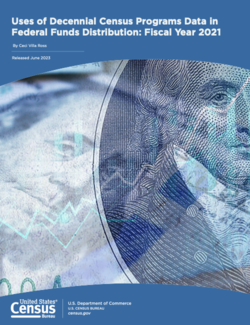Prison gerrymandering is about representation, not money
A new Census Bureau report could raise a common misconception about prison gerrymandering and money. We explain how ending the practice will have a big impact on political representation, but not funding.
by Aleks Kajstura, June 15, 2023
This week, the Census Bureau published an updated report estimating how much federal funding is distributed based on their population data. If you’re familiar with how the Census counts incarcerated people — where they are held on Census day rather than at home — you might assume that will impact where the funding goes. This is a common assumption — one that we’ve debunked several times before — but it doesn’t reflect the truth. With this report’s release, we thought it was worth reviewing the facts that show ending prison gerrymandering has little to no impact on the amount of federal dollars a community receives, but it can have a big impact on a community’s voice in government.
At the center of the misconception is that there is a set amount of dollars that a community receives for every person counted in the Census. It’s true that a lot of funding depends in some way on Census data; The Census Bureau’s report concludes that “as of fiscal year 2021, 353 federal assistance programs used Decennial Census Programs data in whole or in part to distribute more than $2.8 trillion in funds to states, communities, tribal governments, and other recipients. However, this funding isn’t a lump sum that can be converted to a dollar amount per head. As the Census Bureau explains, “this paper merely describes funding programs that use Decennial Census Programs data; it does not attempt to document how such programs do so or whether such data are critical to any particular funding determinations.”
The truth is that money is generally distributed based on complex formulas that strive to match funds to the needs. To the extent that these rely on population totals, it is just one of many components taken into consideration. For example, as you might expect, poverty measures play an important role in funding allocations targeted to fill the needs of impoverished communities. But the federal poverty data used in those formulas does not include incarcerated people.
The myth that funding is distributed as a set amount of money per person is mostly the result of well-intentioned over-generalizations and simplification in an effort to have everyone counted. Desperate not to lose any population in the decennial count, governments often resort to putting a price tag on each person’s failure to respond. For example, as officials in one Georgia community tried to ensure their residents were counted, the local paper made claims such as: “If only one person is counted in a house with four people, it will mean $69,000 less in local coffers over a decade.” It’s a statement that may motivate action, but comes at the expense of the truth.
Certainly, it is important that the Census counts everyone. Census populations determine how legislative districts are drawn and in general terms, play a major role in how federal funds are distributed. But where incarcerated people are counted has less impact on funding flows than people assume.
Ending prison gerrymandering will ensure fair representation that will align legislative priorities with the needs of actual constituents. This will have a direct impact on policy, but will not shift a set amount of money from a prison town to the communities hit hardest by mass incarceration.
Want to help spread the word, or just want a change of formatting?
Here is our fact sheet (including all the sources and explanation of the different Census “censuses” that are used in funding allocations.)




